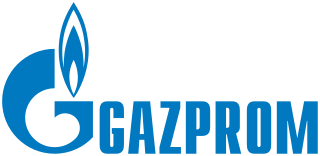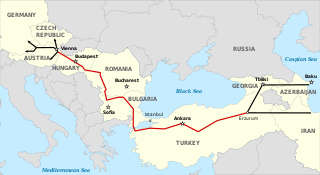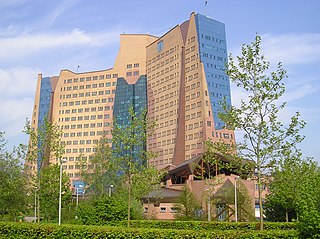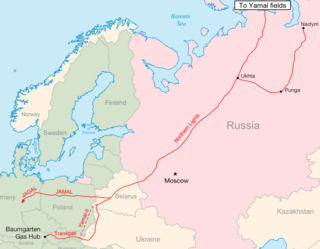
PJSC Gazprom is a Russian majority state-owned multinational energy corporation headquartered in the Lakhta Center in Saint Petersburg. The Gazprom name is a contraction of the Russian words gazovaya promyshlennost. In January 2022, Gazprom displaced Sberbank from the first place in the list of the largest company in Russia by market capitalization. In 2022, the company's revenue amounted to 8 trillion rubles.
Blue Stream is a major trans-Black Sea gas pipeline that carries natural gas to Turkey from Russia. The pipeline has been constructed by the Blue Stream Pipeline B.V., the Netherlands based joint venture of Russian Gazprom and Italian Eni. The Blue Stream Pipeline B.V. is an owner of the subsea section of pipeline, including Beregovaya compressor station, while Gazprom owns and operates the Russian land section of the pipeline and the Turkish land section is owned and operated by the Turkish energy company BOTAŞ. According to Gazprom the pipeline was built with the intent of diversifying Russian gas delivery routes to Turkey and avoiding third countries.
Nord Stream is a pair of offshore natural gas pipelines in Europe that run under the Baltic Sea from Russia to Germany. It consists of the Nord Stream 1 (NS1) pipeline running from Vyborg in northwestern Russia, near Finland, and the Nord Stream 2 (NS2) pipeline running from Ust-Luga in northwestern Russia near Estonia. Both pipelines run to Lubmin in the northeastern German state of Mecklenburg-Vorpommern. Each pipeline contains two pipes, denoted A and B; each of the four pipes is approximately 1,200 kilometres (750 mi) long and with approximate diameters of 1,220 millimetres (48 in). The combined capacity of the four pipes is 110 billion cubic metres per annum of natural gas.

The Nabucco pipeline was a failed natural gas pipeline project from Erzurum, Turkey to Baumgarten an der March, Austria to diversify natural gas suppliers and delivery routes for Europe. The pipeline was to lessen European dependence on Russian energy. The project was backed by several European Union states and the United States and was seen as rival to the Gazprom-Eni South Stream pipeline project. The main supplier was to be Iraq with potential supplies from Azerbaijan, Turkmenistan, and Egypt.

The Yamal–Europe natural gas pipeline is a 4,107-kilometre-long (2,552 mi) pipeline connecting Russian natural gas fields in the Yamal Peninsula and Western Siberia with Poland and Germany, through Belarus. The Poland portion ceased operating in 2022.
The Baltic Gas Interconnector was a 2001 project of a natural gas submarine pipeline in the Baltic Sea between Germany, Denmark and Sweden. The pipeline would connect the existing pipeline networks of southern Scandinavian and Continental European countries in order to secure uninterrupted supply of natural gas.

Nord Stream AG is a consortium for construction and operation of the Nord Stream 1 submarine pipeline between Vyborg in Russia and Greifswald in Germany. The consortium was incorporated in Zug, Switzerland, on 30 November 2005.

N.V. Nederlandse Gasunie is a Dutch natural gas infrastructure and transportation company operating in the Netherlands and Germany. Gasunie owns the Netherlands gas transmission network with a total length of over 12,000 kilometres (7,500 mi) and 3,100 kilometres (1,900 mi) long network in Germany.

The OPAL (Ostsee-Pipeline-Anbindungsleitung) is a natural gas pipeline in Germany alongside the German eastern border. The OPAL pipeline is one of two projected pipelines connecting the Nord Stream 1 pipeline to the existing pipeline grid in Middle and Western Europe, the other one being the NEL pipeline.

The NEL (Nordeuropäische Erdgasleitung, formerly known as Norddeutsche Erdgasleitung, is a 440 kilometres long natural gas pipeline in Germany.
The Trans-Balkan pipeline is a natural gas pipeline between Turkey and Ukraine with branches to Greece and North Macedonia. It was used by Gazprom for gas deliveries through Balkan countries to Turkey. Before construction of the Blue Stream pipeline it was the only international natural gas pipeline supplying Turkey.

South Stream is a canceled pipeline project to transport natural gas of the Russian Federation through the Black Sea to Bulgaria and through Serbia, Hungary and Slovenia further to Austria. It was never finished.
Gryazovets–Vyborg gas pipeline is a branch pipeline of the Northern Lights pipeline from Gryazovets in central part of Russian Federation through Vologda and Leningrad oblasts to Saint Petersburg, Vyborg, and Finland. The third line of this pipeline was built to feed the Nord Stream 1 pipeline.

The Bacton Gas Terminal is a complex of six gas terminals within four sites located on the North Sea coast of North Norfolk in the United Kingdom. The sites are near Paston and between Bacton and Mundesley; the nearest town is North Walsham.
The United Kingdom's National Transmission System (NTS) is the network of gas pipelines that supply gas to about forty power stations and large industrial users from natural gas terminals situated on the coast, and to gas distribution companies that supply commercial and domestic users. It covers Great Britain, i.e. England, Wales and Scotland.

Northern Lights is a natural gas pipeline system in Russia and Belarus. It is one of the main pipelines supplying north-western Russia and is an important transit route for Russian gas to Europe.

In 2021 Russia was the world's second-largest producer of natural gas, producing an estimated 701 billion cubic meters (bcm) of gas a year, and the world's largest natural gas exporter, shipping an estimated 250 bcm a year. In 2022 the export market was significantly downsized, following the Russian invasion of Ukraine and Russia reducing exports after countries refused to pay in rubles.
TurkStream is a natural gas pipeline running from Russia to Turkey. It starts from Russkaya compressor station near Anapa in Russia's Krasnodar Region, crossing the Black Sea to the receiving terminal at Kıyıköy. Some gas flows onwards to the European Union.
Nord Stream 2 is a 1,234-kilometre-long (767 mi) natural gas pipeline from Russia to Germany running through the Baltic Sea, financed by Gazprom and several European energy companies. Feasibility studies began in 2011 to expand the Nord Stream 1 line and double annual capacity to 110 billion cubic metres, with construction beginning in 2018. It was completed in September 2021, but has not yet entered service. Planning and construction of the pipeline were mired in political controversy over fears that Russia would use it, one of 23 pipelines between Europe and Russia, for geopolitical advantage with Europe and Ukraine.

Nord Stream is a network of offshore natural gas pipelines which run under the Baltic Sea from Russia to Germany to provide Western Europe with natural gas. It comprises two separate projects, Nord Stream 1 and Nord Stream 2. Both pipelines each comprise two pipes, NS1 A and B as well as NS2 A and B, for a total of 4 physical pipes. Both pipelines start in Russia and land in Lubmin, Germany. NordStream is owned by a consortium of 5 energy companies: Gazprom international projects North 1 LLC, Wintershall Dea AG, PEG Infrastruktur AG (E.ON), N.V. Nederlandse Gasunie and ENGIE. It was the first pipeline that bypassed Ukraine and Poland to deliver Russian natural gas directly to West Europe.












